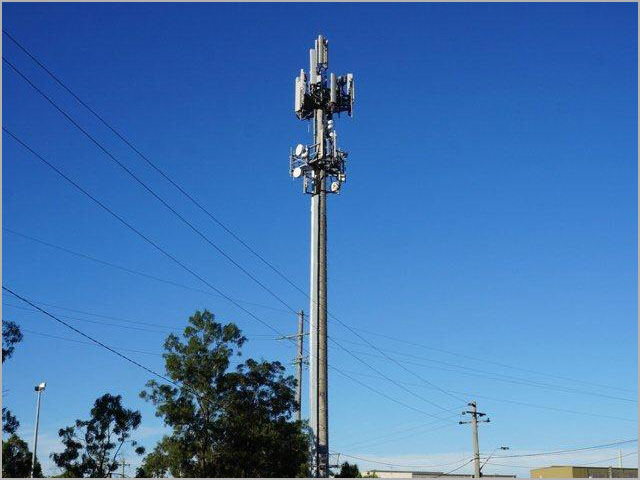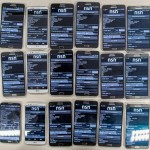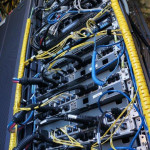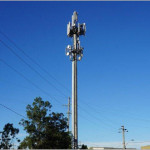
Note: The 2.3Gbps speeds in this article refer to the total amount of bandwidth allocated to a mobile tower; not the individual speeds which individual mobile broadband devices connected to that tower are able to achieve (the fastest individual speed was 165Mbps). Any comments conflating these two technical concepts will be deleted.
news Optus last week announced it had achieved what it described as “a massive world first”, generating a total of 2.3 gigabits per second (Gbps) site throughput on one of its custom-built mobile phone towers.
Optus’ ‘Gigasites’ are two live network test sites built to test Optus’ entire spectrum assets in terms of total capacity, throughput capability, and number of network layers. According to Optus, both sites are world-firsts in a number of ways, including the fact that they’ve achieved the highest total throughput ever achieved on a live mobile network site* (a total of 1.65 to 2.32Gbps^), the fact that they’ve used the most spectrum ever on a live network site (a total of 286.8 MHz, across seven spectrum bands), the fact that they use the greatest number of 4G layers on a single site (five) and a “never-seen-before” eight technology/band combinations.
The two Gigasites were built with Optus’ network partners Nokia Solutions and Networks (NSN) and Huawei. One site has been built at St Marys in Sydney’s western suburbs, and the other built at Lambton in Newcastle, approximately 160 km north of Sydney.
Andrew Smith, Optus Vice President of Mobile Engineering, said in a statement last week: “Our Gigasite project is about demonstrating our network of the future, and how Optus will be able to provide our customers with unparalleled capacity to meet their ever increasing appetite for data, and deliver a faster, more consistent network experience. Optus’ market-leading metro spectrum assets mean that we have the capacity to provide exceptional customer experience to our mobile data customers, even under extremely heavy network loads.”
“The trial was conducted on our live network, not in lab conditions – but with real devices, out in the field,” Smith added.
To meet the challenge of trying to generate over 2 Gbps of network traffic in the field, Optus and its vendor partners mobilised a total of 16 test drive vehicles, 21 engineers, 58 devices (smartphones and dongles) and 31 laptops in order to load up the two sites with data traffic. The next stage of testing will provide Optus with detailed information on how best to utilise such a vast amount of spectrum.
“As 4G continues to evolve, being able to optimally leverage a multi-band network strategy is increasingly important. Optus, in partnership with our vendors, expects to lead the world in its ability to plan, design, optimise and manage mobile network data traffic across multiple spectrum layers,” said Smith.
Optus used commercial devices wherever possible in its tests. In particular, Optus worked with Samsung, LG and Huawei in providing the latest multiband smartphones for testing.
The Gigasites also represent Australia’s first LTE 3500 network trial, according to Optus. Smith said: “In the coming months, we’ll explore how the 3500 MHz spectrum could be used in a future mobile network. This trial will provide important data which will help inform our decision making for the 3500 MHz spectrum band.”
Optus Gigasite technical facts (supplied by Optus):
- Two Gigasites built, each consisting of three sectors.
- One Gigasite comprised seven spectrum layers and eight band/technology combinations: 4G (FDD) 700 MHz, 2G 900 MHz, 3G 900 MHz, 4G (FDD) 1800 MHz, 3G 2100 MHz, 4G (TDD) 2300 MHz, 4G (FDD) 2600 MHz, 4G (TDD) 3500 MHz. The other gigasite excluded 3500 MHz.
- The total capacity measured ranged from 1.65 Gbps total site throughput over six spectrum bands (226.8 MHz total spectrum), to 2.32 Gbps over seven spectrum bands (286.8 MHz total spectrum).
- The highest site throughput achieved on a single spectrum layer was 1.11 Gbps for 4G (TDD) on the 2300 MHz layer.
- The highest speed achieved to any single user device was 165 Mbps for 4G (TDD) on 3500 MHz.
- The Gigasites were connected to the live Optus mobile core network, as used by all Optus mobile customers.
- Multi-band 10 and 12 port antennas were used on the Gigasites, spanning 700 to 2600 MHz. Separate antennas were used for 3500 MHz.
- Optus owns licences to all the spectrum layers used. 700 MHz and 2600 MHz spectrum was acquired at auction in 2013, however trial licences were obtained for 700 and 2600 MHz for the Gigasites ahead of the spectrum licences being issued in these bands.
- The radio equipment for each Gigasite comprised up to 26 radio modules, weighing up to 400kg in total.
- The most spectrum used for any single layer was 80 MHz, for 4G (TDD) 2300 MHz.
- 16 test drive vehicles, 21 engineers, 58 devices and 31 laptops were used to load the Gigasites in the field.
* Total site throughput was measured at a dedicated content server connected to the Optus live core network, and represents the aggregate of all data throughput across all network layers at a ‘gigasite’ at a given instant in time. ^ 1.65 Gbps was achieved using 226.8 MHz spectrum, 2.32 Gbps was achieved using 286.8 MHz spectrum.
opinion/analysis
I have no idea if 2.3Gbps is a lot in terms of the total mobile tower throughput, but Optus certainly seems pretty excited about it. Perhaps someone with knowledge of this situation can chime in in the comments below to provide context?
Image credit: Optus




If you consider that most cell sites would be lucky to have 20 MHz of spectrum, over 200 MHz is friggin huge! I know there are complications to doing this, but I have often wondered why the various carriers don’t run more dual band networks, especially Telstra that have the most customers and all that 1800 spectrum that was unused before 4G.
Quite amazing.
But why? As soon as the available bandwidth gets chewed up by X subscribers the inevitable problem occurs.
Taking it to the bush? Perhaps not – back haul would require fibre anyway as a typical 16Ghz Microwave dish would struggle (so one would likely just opt for FTTP or FTTN)
I don’t quite share OPTUS enthusiasm. : )
Pcell.
http://www.berryreview.com/2014/03/03/pcell-will-put-phone-lte-fast-lane/
Well isn’t that just wonderful. Yawn.
Now back to the real world. If only we could get even a 3G signal where I live. That would be news!
I finally figured out a few years ago why they call that thing I have a mobile phone.
It’s because I have to take it 5km down the road before it will work!!!!!!!!!!!
Useless technology!
Well isn’t that just wonderful. Yawn.
Now back to the real world. If only we could get even a 3G signal where I live. That would be news!
I finally figured out a few years ago while they call that thing I have a mobile phone.
It’s because I have to take it 5km down the road before it will work!!!!!!!!!!!
Useless technology!
Comments are closed.